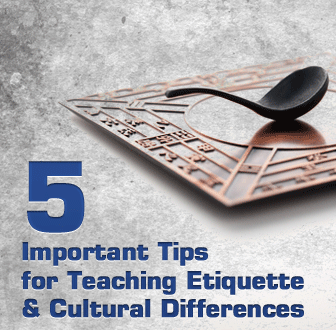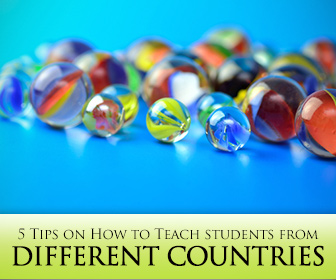Letís Be P.C. Five Important Tips for Teaching Etiquette and Cultural Differences


Often when we have a group of students like this we feel awkward or even a bit insecure. What should or shouldn’t I talk about? Are there topics I should avoid? Should I have the student interact or not? These are among many of the questions we may ask ourselves. The fact that there are basic standards for social interaction in every culture and that they might differ from place to place might feel daunting for the teacher. How far away you stand from another person when talking, whether or not to make eye contact, how you express yourself in public, how you conduct business, etc, are among few examples of how we are different. Nowadays “different” is not a problem to most, the world is shrinking and technology has brought us all closer together. Success in a culturally diverse class is possible because diversity in the classroom is actually a huge asset. However, there are a few things you will need to take into account first.

We are all different and that is no secret. Not only because we may not share the same culture but also because we, as people, have different histories, families, tastes, needs and the list goes on and on. Acknowledging we are all different is where respect for differences begins. As funny as it may sound, one of the few things everyone has in common is the fact that we are all different. So, one of the first things you need to make sure everyone understands is that it’s great that differences exist.
Sharing culture is vital to understanding it. Very often people feel uneasy about things they aren’t familiar with or don’t understand. In our culturally diverse classroom sharing is vital. Once we understand, it’s easier to accept. There are many ways to embrace these differences constructively. An all time classic is to have students introduce themselves. They can talk about where they are from, where they work, what they like etc. This helps bring things out in the open. You can ask questions about things you are unfamiliar with regarding their culture too. In fact, this can be done as often as you want with most of the material covered in class. If it’s just you and one student, you can talk about yourself and a fictitious character. Keep this in mind, you should always be very cautious not to cross any lines that might be considered too personal.
Not everything is about differences, after all there are many things we can have in common even if we are from different cultures. We might, for instance, have the same taste in books or movies regardless of where we were born or grew up. In a diverse classroom it’s also about sharing what we have in common despite what makes us different. Pointing that out when students are sharing views or opinions is always healthy. Also, we must always keep in mind the most important thing your students have in common; though the reasons aren’t always the same, they are studying the same language.
Understanding cultural needs is very much related to class objectives. Objectives are set depending on many things, mainly, why they are learning that language. This is something many of the students might have in common. What might change, however, is how the learning takes place, what motivates them, even challenges they might face. You have to plan lessons with these things in mind if what we are going for is a learner centered classroom. Leaving countries and culture aside, every student has needs that have to be met, and we have to make sure we know what they are.
Needless to say, knowing about and understanding different cultures gives people a huge advantage. It enables students to communicate at a different level and in the world of work, for instance, it gives them a whole new outlook, as well as a set of skills. It makes students stronger from a social point of view and as a consequence better able to compete in the new global economy. People who have had contact with diverse cultures have more language and negotiating skills, new ways of thinking and creative solutions to tough problems.
Keep your lessons natural, organic and above all relax. There is nothing to fear if you have done your homework.